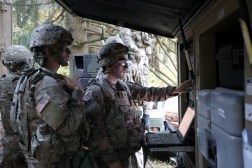Air Force develops new model for battle management to underpin requirements for ABMS

The Air Force has developed a model for how battle management should be conducted in the future — an initiative that officials see as a requirement for the service’s forthcoming Advanced Battle Management System architecture.
ABMS is the Air Force’s contribution to the Pentagon’s Joint All-Domain Command and Control (JADC2) concept, which seeks to connect sensors and shooters, and provide battlefield commanders with the right information to make faster — and better — decisions.
While industry has developed sophisticated technical designs and solutions for what they believe the Air Force needs for ABMS, officials told FedScoop that demonstrations of these capabilities operated on either flawed or legacy models for how to conduct battle management, which could lead to commanders and troops making bad decisions, albeit on a faster timeline.
Instead, in order to get to the right technical solution, officials with the JADC2 cross-functional team on the Air Force Futures staff had to essentially reimagine what battle management should be to create the underbelly for technical solutions that use advanced algorithms.
“If we do not understand the process of which to make a decision, there is no technology that you’re going to develop that’s going to suddenly turn this tide,” Brig. Gen. Jeff Valenzia, JADC2 cross-functional team lead for Air Force Futures, told FedScoop in a recent interview.
Col. Jon “Beep” Zall, a member of Valenzia’s team who was at the forefront of developing the model, pointed to the need to introduce innovative technologies and do things differently. He quoted automobile pioneer Henry Ford, who said “If I asked people what they wanted, they would have said faster horses.”
“The idea that if all we [in the Air Force] do is just incremental improvements to the ‘as is’ we won’t necessarily meet our goals and objectives for advanced battle management or for JADC2 writ large,” Zall said.
Personnel involved in modeling and simulation discovered that when observing command and control at major commands, such as Pacific Air Forces and Air Forces in Europe–Air Forces Africa, they were able to characterize the process but they couldn’t determine if it was good.
“On acquisitions, when they’re thinking about the ABMS digital infrastructure, which will undergird many of the capabilities … as they develop the ‘to be,’ how do they know what the ‘to be’ ought to be?” Zall said. “What we realized through the demand for rigor from leadership [was] the need to understand the ‘as is’ from analysis and the ‘to be’ for acquisitions. What we postulate is there’s this third thing, I’ll just call it the ‘must do.’ That’s what our model represents.”
Using systems engineering, the team sought to look at what command and control should look like going forward.
Everyone has a different view of battle management, which is to be expected, but the model will hopefully bring some uniformity and common lexicon to the fore.
“What this model will hopefully do is it will converge our mental models of what battle management is, and then we have a common point of departure as we develop things,” Zall said. “We think one of the things that we hope to add value to the joint and mission partner conversation is a common mental model. That’s what we’re trying to achieve.”
Officials told FedScoop that, in their view, joint command and control doesn’t really exist now. This new model would be the first instantiation and provide the building blocks to disaggregate the functions — allowing for a precise understanding for how to do it and how to implement technical solutions to aid it.
“What this [model] allows us to do is to understand what it means to battle manage, because ultimately, what it delivers is requirements that are going to drive [tactics, techniques and procedures] modernization, the non-materiel modernization, and the technical modernization,” Valenzia said.
Through their work, the team devised 13 sub-functions for battle management that units can organize and place in certain organizations as it best suits their missions.
The sub-functions, among others, include: parse orders and plans, facilitate coordination and collaboration, and improving situational understanding.
“Today, what we do is we don’t understand these 13 [sub-functions]. It’s a black box. We park them all over the place and we don’t even know how the black boxes interact with each other,” Valenzia said. “This is what we’re trying to remove that veil and put that level of precision on.”
He said this model introduces a new way to generate requirements translating into a digital exchange requirement design.
It also holds organizations and industry more accountable, Zall said. Instead of an organization interpreting how one wants to do battle management and developing a solution for it, now, with specific information exchange requirements for each function, they can point to exactly how that process should be done.
The officials noted that this model hasn’t been formally adopted yet. Using the systems engineering model, they plan to model and simulate against it. They’ll also be sending it to industry to kick the tires on it and come back with their ideas.
“Industry has been asking us questions that we haven’t been able to answer. This model lets us now answer those questions,” Valenzia said. “The goal is we create one disciplined approach that uses a common set of lexicon.”
Additionally, the model will be headed to U.S. Indo-Pacific Command soon to put it through its paces.
“We have to prove it still,” Valenzia said. “Our hypothesis is that what this model has become is the seed to create what we think will be the first instantiation of joint C2 … This is why we are partnered with the Navy initially, because the Indo-Pacom was our pacing theater” where Pentagon officials see China as the United States’ top military rival.
Air Force officials said they need buy-in from the other services and international partners. Already the UK, Canada, Australia, Japan and Germany have said they’re interested in partnering with the model, the officials noted.
The plan is to brief what the team found to four-star officers at the Pentagon in January.
“We’re going to start writing an operational concept that then uses this model,” Valenzia said.
The vision is that this new model should be able to stand the test of time and be flexible with changes in doctrine.
“This model … also describes the battle management that people who aren’t even lieutenants yet will be executing in 2032 and beyond,” Zall said. “That’s our hypothesis.”




